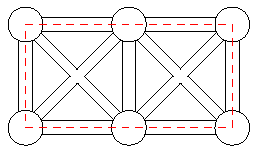POJ 1450 Gridland(我的水题之路——找规律)
来源:互联网 发布:淘宝开店诈骗 编辑:程序博客网 时间:2024/06/10 14:35
Gridland
Time Limit: 1000MS Memory Limit: 10000KTotal Submissions: 5400 Accepted: 2972
Description
Background
For years, computer scientists have been trying to find efficient solutions to different computing problems. For some of them efficient algorithms are already available, these are the "easy" problems like sorting, evaluating a polynomial or finding the shortest path in a graph. For the "hard" ones only exponential-time algorithms are known. The traveling-salesman problem belongs to this latter group. Given a set of N towns and roads between these towns, the problem is to compute the shortest path allowing a salesman to visit each of the towns once and only once and return to the starting point.
Problem
The president of Gridland has hired you to design a program that calculates the length of the shortest traveling-salesman tour for the towns in the country. In Gridland, there is one town at each of the points of a rectangular grid. Roads run from every town in the directions North, Northwest, West, Southwest, South, Southeast, East, and Northeast, provided that there is a neighbouring town in that direction. The distance between neighbouring towns in directions North-South or East-West is 1 unit. The length of the roads is measured by the Euclidean distance. For example, Figure 7 shows 2 * 3-Gridland, i.e., a rectangular grid of dimensions 2 by 3. In 2 * 3-Gridland, the shortest tour has length 6.

Figure 7: A traveling-salesman tour in 2 ? 3-Gridland.
For years, computer scientists have been trying to find efficient solutions to different computing problems. For some of them efficient algorithms are already available, these are the "easy" problems like sorting, evaluating a polynomial or finding the shortest path in a graph. For the "hard" ones only exponential-time algorithms are known. The traveling-salesman problem belongs to this latter group. Given a set of N towns and roads between these towns, the problem is to compute the shortest path allowing a salesman to visit each of the towns once and only once and return to the starting point.
Problem
The president of Gridland has hired you to design a program that calculates the length of the shortest traveling-salesman tour for the towns in the country. In Gridland, there is one town at each of the points of a rectangular grid. Roads run from every town in the directions North, Northwest, West, Southwest, South, Southeast, East, and Northeast, provided that there is a neighbouring town in that direction. The distance between neighbouring towns in directions North-South or East-West is 1 unit. The length of the roads is measured by the Euclidean distance. For example, Figure 7 shows 2 * 3-Gridland, i.e., a rectangular grid of dimensions 2 by 3. In 2 * 3-Gridland, the shortest tour has length 6.

Figure 7: A traveling-salesman tour in 2 ? 3-Gridland.
Input
The first line contains the number of scenarios.
For each scenario, the grid dimensions m and n will be given as two integer numbers in a single line, separated by a single blank, satisfying 1 < m < 50 and 1 < n < 50.
For each scenario, the grid dimensions m and n will be given as two integer numbers in a single line, separated by a single blank, satisfying 1 < m < 50 and 1 < n < 50.
Output
The output for each scenario begins with a line containing "Scenario #i:", where i is the number of the scenario starting at 1. In the next line, print the length of the shortest traveling-salesman tour rounded to two decimal digits. The output for every scenario ends with a blank line.
Sample Input
22 22 3
Sample Output
Scenario #1:4.00Scenario #2:6.00
Source
Northwestern Europe 2001
题中给出两个数字n和m,将组成一个n*m个点的矩阵,矩阵相邻的两点之间有,东、南、西、北、东南、东北、西南、西北八个方向。那么我需要从某一点出发,遍历所有的点有且仅有一次,问最短的距离是多少?
一开始看到这题以为是图论的题目,但是看到题中的解释,就觉得这个是一道找规律的题目,所以在演草纸上试了几遍就发现了如下规律:
1)如果n和m都为奇数,则距离为n * m + 1.414 - 1;
2)否则,距离为n*m;
注意点:
1)每个结果最后有一个空行
代码(1AC):
#include <cstdio>#include <cstdlib>int main(void){ int casenum, ii; int n, m; double result; scanf("%d", &casenum); for (ii = 1; ii <= casenum; ii++){ scanf("%d%d", &n, &m); if (n % 2 == 1 && m % 2 == 1){ result = n * m + 0.41; } else{ result = n * m; } printf("Scenario #%d:\n", ii); printf("%.2f\n\n", result); } return 0;}- POJ 1450 Gridland(我的水题之路——找规律)
- hdoj 1046 Gridland(找规律)
- POJ1450 Gridland [找规律]
- Gridland ZOJ1037(规律)
- ZOJ 1037 && HDU 1046 Gridland (找规律)
- HDU ACM 1046 Gridland 找规律
- 【商旅问题、找规律】ZOJ 1037 Gridland
- POJ——2506(找规律加大数乘法 )
- POJ 1068(找规律)
- hdu 1046 Gridland(规律题)
- poj 1450 Gridland
- poj 1450 Gridland
- POJ 1450 Gridland
- poj 1450--Gridland
- poj 1450---Gridland
- HDU 1046.Gridland【非搜索,找规律】【8月25】
- hdu——2045(找规律的递推题)
- codeforce(找规律的简单题)
- use Fiddler to debug Development Fabric
- 一个拼图游戏,包含很多内容。
- 一个android应用向Home screen添加多个Widget
- window下查当前运行进程
- java类文件批量编译语法及依赖类文件的运行
- POJ 1450 Gridland(我的水题之路——找规律)
- socket实现大型文件传输 .
- 正则表达式基础(一)
- 3.Coding Struts 2 Actions
- POJ 1493 Machined Surfaces(我的水题之路——移动后的空格)
- MyEclipse优化加载速度和去掉一些没用的设置
- POJ 1488 TEX Quotes(我的水题之路——暴水,字符转换)
- CentOS 5.x 系统下使用yum 升级php到5.2.x
- 使用递归方式遍历指定磁盘路径下的文件及文件夹


